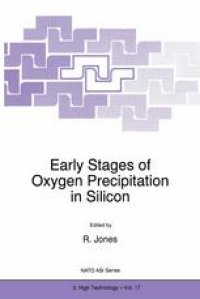
Ebook: Early Stages of Oxygen Precipitation in Silicon
- Tags: Condensed Matter Physics, Solid State Physics, Spectroscopy and Microscopy, Optical and Electronic Materials, Characterization and Evaluation of Materials
- Series: NATO ASI Series 17
- Year: 1996
- Publisher: Springer Netherlands
- Edition: 1
- Language: English
- pdf
It was fOlllld as long ago as 1954 that heating oxygen rich silicon to around 450°C produced electrical active defects - the so called thermal donors. The inference was that the donors were created by some defect produced by the aggregation of oxygen. Since then, there has been an enor mous amount of work carried out to elucidate the detailed mechanism by which they, and other defects, are generated. This task has been made all the more relevant as silicon is one of the most important technological ma terials in everyday use and oxygen is its most common impurity. However, even after forty years, the details of the processes by which the donors and other defects are generated are still obscure. The difficulty of the problem is made more apparent when it is realised that there is only one oxygen atom in about ten thousand silicon atoms and so it is difficult to devise experiments to 'see' what happens during the early stages of oxygen precipitation when complexes of two, three or four 0xygen atoms are formed. However, new important new findings have emerged from experiments such as the careful monitoring of the changes in the infra red lattice absorption spectra over long durations, the observation of the growth of new bands which are correlated with electronic infra-red data, and high resolution ENDOR studies. In addition, progress has been made in the improved control of samples containing oxygen, carbon, nitrogen and hydrogen.
While the discovery that heating oxygen-rich silicon to around 450°C produces electrically active defects dates back to 1954, the details of the processes by which the donors and other defects are generated remain obscure today. The fact that there is only one oxygen atom in about ten thousand silicon atoms means that it is difficult to devise experiments to see what happens during the early stages of oxygen precipitation when complexes of two, three or four oxygen atoms are formed. But important new findings are emerging from the careful monitoring of the changes in IR lattice absorption spectra over long time periods, observation of the growth of new bands that are correlated with electronic IR data, and high resolution ENDOR studies. Better samples are also becoming available for study, and great advances have been made in modelling techniques.
The emphasis of the present book is on the fundamental issues of oxygen diffusion, the properties of small oxygen aggregates, and the effects of H, N, and C on oxygen precipitation. With extended reviews by G.D. Watkins, R.C. Newman, J.L. Lindstrom, C.A.J. Amerlaan, M. Spaeth, V. Merkevich, J. Weber, R. Jones, P. Deak, S.K. Estreicher, S.T. Pantelides, M. Suezawa, U. Gosele, K. Sumino, B. Pajot and E.C. Lightowlers in addition to 26 contributed papers, the proceedings contain the latest results on the vibrational spectroscopy of thermal donors, the enhanced diffusion of oxygen dimers, magnetic resonance, theoretical modelling, and the influence of H on oxygen diffusion.
Audience: All researchers working in the field of silicon technology, especially those dealing with defects and defect control in Czochralski silicon.